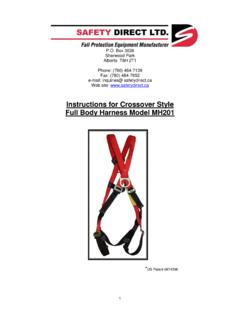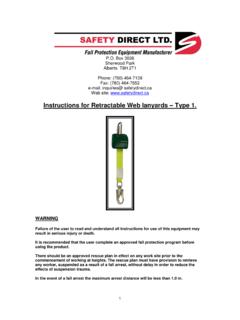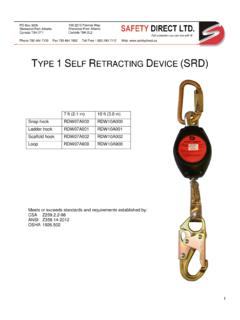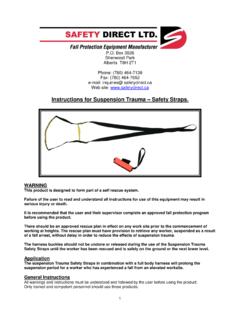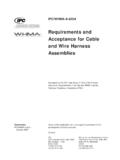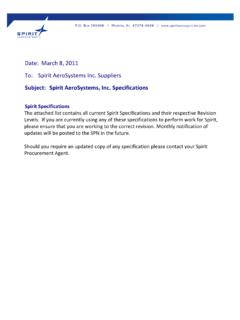Transcription of Instructions for Energy Absorbing ‘Y’, Bypass …
1 Box 3026. Sherwood Park Alberta T8H 2T1. Phone: (780) 464-7139. Fax: (780) 464-7652. e-mail: inquiries@ Web site: Instructions for Energy Absorbing Y', Bypass Lanyards. WARNING. Failure of the user to read and understand all Instructions for use of this equipment may result in serious injury or death. It is recommended that the user complete an approved fall protection program before using the product. There should be an approved rescue plan in effect on any work site prior to the commencement of working at heights. The rescue plan must have provision to retrieve any worker, suspended as a result of a fall arrest, without delay in order to reduce the effects of suspension trauma.
2 In the event of a fall arrest and the Energy absorber on the lanyard deploys, the deployed length of the lanyard can increase by up to m ( ft). The total fall distances should be calculated using this increased deployed length to ensure that there is sufficient clearance to the surface below the worksite. Refer to product label for maximum deployed length of lanyard. General Instructions All warning labels and Instructions must be understood and followed by the user before using the product. All users must understand the relevant regulations and usage standards for fall protection, pertaining to this product, in the jurisdiction in which it is being used.
3 Only trained and competent personnel should use these products. All fall protection equipment must be visually inspected by the worker prior to each use. 1. All fall protection equipment must be inspected by a competent person on a regular basis (at least annually). Fall protection equipment must not be altered or modified in any way. To reduce the possibility of accidental release, a competent person must ensure that all the system components are compatible. Any equipment exhibiting deterioration, damage or deformation must be removed from service immediately and inspected by a competent person before being returned to service.
4 All equipment subjected to a fall arrest or fall incident must be removed from service immediately and be tagged for further inspection to determine the disposition of the equipment. The Y' or Bypass lanyard is intended for use in situations where the worker must be Tied-Off . 100% of the time at height, but must move between workstations in order to complete the task. The Y' or Bypass lanyard is designed for only momentary attachment to two (2) anchorages. Attachment of the two legs to separate anchorages simultaneously can result in serious overloading of the lanyard, if the distance between the anchorages exceeds times the lanyard length, or if the angle between the lanyard leg and the horizontal is less than 30 (degrees).
5 If the distance between the anchorages exceeds times the lanyard leg length then a horizontal lifeline should be used to facilitate the point-to-point transfer. Failure to observe these restrictions will result in overloading of the lanyard, and could result in catastrophic failure of the lanyard in the event of a fall arrest. During normal use only one of the lanyard legs should be tied off to an anchorage. The locking snap hooks at the end of the lanyard legs should have the smallest throat opening necessary to accomplish the task. The use of oversized locking snap hooks could increase the possibility of accidental rollout or overloading of the gate on the snap hook.
6 Usage Instructions Failure to follow these Instructions could result in catastrophic failure of the lanyard in the event of a fall arrest situation. For Fall Arrest applications the locking snap hook adjacent to the Energy Absorber Pack must be attached to the Dorsal (rear) D-ring of an approved full body harness and visual confirmation of the locking of the gate on the snap hook must be obtained. 2. The lanyard should be attached to an approved anchorage with a load rating of 5,000 lbs or in accordance with the regulations in the jurisdiction in which the equipment is being used.
7 Wherever possible the anchorage should be chosen so as to be directly above the work site in order to reduce or eliminate the possibility of a swing fall. When selecting the anchorage ensure that there is sufficient clearance to the surface below to allow for the following: 1) Deployment of the Energy absorber. 2) Stretch of the full body harness. 3) Slippage of the Dorsal D-ring on the full body harness. 4) Stretch of the anchorage means if applicable. The length of the lanyard should be the minimum needed to accomplish the task, but should not exceed metres (6 feet) unless the anchorage is above the attachment point to the full body harness.
8 During normal use only one of the legs of the lanyard should be attached to the anchorage point, the remaining leg should be attached to an approved location point on the harness that is designed to tear away if the leg becomes snagged during use. The lanyard leg not in use must not be attached to the D-ring or webbing component of the full body harness. Both legs should only be attached, simultaneously, to separate anchorages during the traversing process. If the distance between anchorages in the traversing process exceeds times the lanyard leg length, (usually approximately metres [1 foot] less than the lanyard's specified length due to the length of the Energy absorber), then provision must be made to facilitate the traverse.
9 The lanyard should not be modified or altered in any way. In the event that a lanyard is involved in a fall arrest situation it must be removed from service immediately and discarded. In the event of a fall arrest the suspended worker should be rescued without delay in order to minimize the effects of suspension trauma. Inspection All lanyards should be inspected by the user before each use and should be visually inspected by a competent person, other than the user, on an annual basis or sooner. A record of these inspections should be kept in a log.
10 When an inspection reveals any defects the lanyard must be removed from fall arrest service immediately and be tagged to preclude any further use. The lanyard should not be returned to service until it has been reworked or repaired by the manufacturer. The lanyard should be removed from service immediately if an inspection reveals any of the following: a) that the lanyard has been subjected to fall arrest service and the Energy absorber has been partially deployed. b) there is evidence of any corrosion or deformation of the hardware connectors and components, including cracks, sharp edges, chemical attack, excessive heat exposure or alteration in any way.
